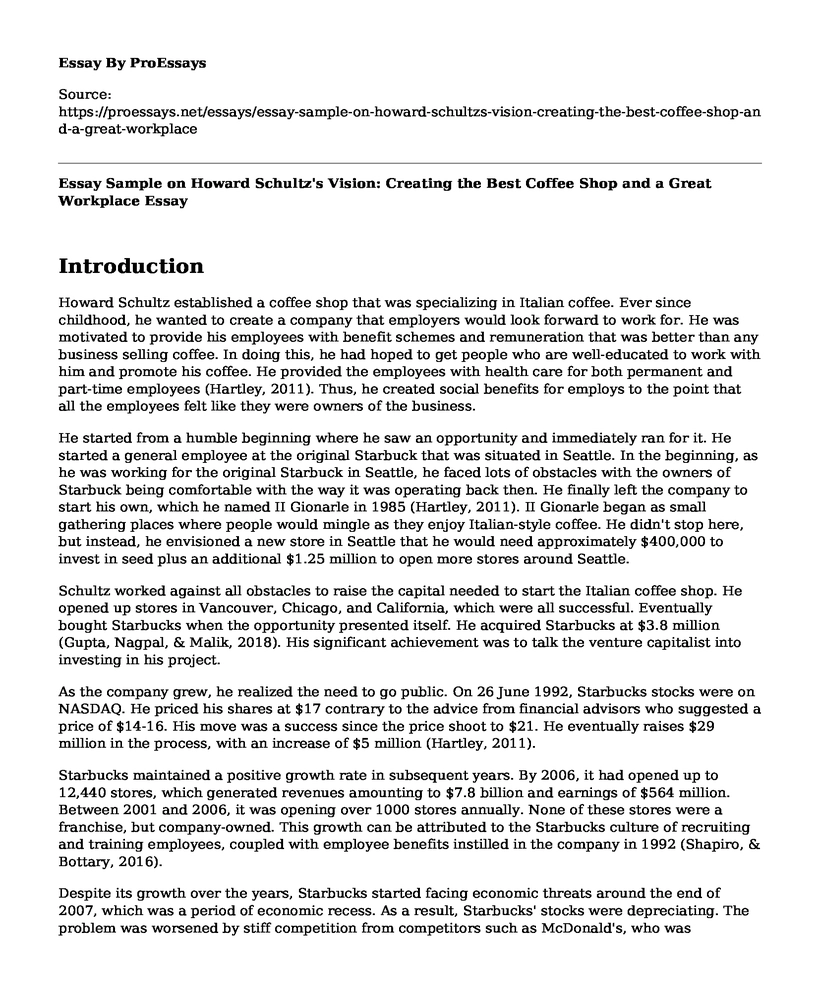Introduction
Howard Schultz established a coffee shop that was specializing in Italian coffee. Ever since childhood, he wanted to create a company that employers would look forward to work for. He was motivated to provide his employees with benefit schemes and remuneration that was better than any business selling coffee. In doing this, he had hoped to get people who are well-educated to work with him and promote his coffee. He provided the employees with health care for both permanent and part-time employees (Hartley, 2011). Thus, he created social benefits for employs to the point that all the employees felt like they were owners of the business.
He started from a humble beginning where he saw an opportunity and immediately ran for it. He started a general employee at the original Starbuck that was situated in Seattle. In the beginning, as he was working for the original Starbuck in Seattle, he faced lots of obstacles with the owners of Starbuck being comfortable with the way it was operating back then. He finally left the company to start his own, which he named II Gionarle in 1985 (Hartley, 2011). II Gionarle began as small gathering places where people would mingle as they enjoy Italian-style coffee. He didn't stop here, but instead, he envisioned a new store in Seattle that he would need approximately $400,000 to invest in seed plus an additional $1.25 million to open more stores around Seattle.
Schultz worked against all obstacles to raise the capital needed to start the Italian coffee shop. He opened up stores in Vancouver, Chicago, and California, which were all successful. Eventually bought Starbucks when the opportunity presented itself. He acquired Starbucks at $3.8 million (Gupta, Nagpal, & Malik, 2018). His significant achievement was to talk the venture capitalist into investing in his project.
As the company grew, he realized the need to go public. On 26 June 1992, Starbucks stocks were on NASDAQ. He priced his shares at $17 contrary to the advice from financial advisors who suggested a price of $14-16. His move was a success since the price shoot to $21. He eventually raises $29 million in the process, with an increase of $5 million (Hartley, 2011).
Starbucks maintained a positive growth rate in subsequent years. By 2006, it had opened up to 12,440 stores, which generated revenues amounting to $7.8 billion and earnings of $564 million. Between 2001 and 2006, it was opening over 1000 stores annually. None of these stores were a franchise, but company-owned. This growth can be attributed to the Starbucks culture of recruiting and training employees, coupled with employee benefits instilled in the company in 1992 (Shapiro, & Bottary, 2016).
Despite its growth over the years, Starbucks started facing economic threats around the end of 2007, which was a period of economic recess. As a result, Starbucks' stocks were depreciating. The problem was worsened by stiff competition from competitors such as McDonald's, who was upgrading its coffee and investing heavily in the advertisement. McDonald's had spent more than $60 million to advertise its coffee. McDonald's was also selling cappuccino at prices that were $3 less than Starbucks. However, Starbucks retaliated by training its employees to return to the earlier practices that increased the market to the company's products. It also closed down nonperforming stores and introduced Frappuccino that drew more people to the stores (Gupta, Nagpal, & Malik, 2018).
Conclusion
This case analysis outlines the benefits that a company can get by embracing Starbucks' business model. Starbucks identified employees as a critical component in its process. It caters to employees' interests, which stands out to be one of the strongest pillars of Starbucks model. The employees, in return, served the company wholeheartedly. They not only worked hard in the company but also improved the image of the company and approached the customers aim at continued customer return. Starbucks had the benefit of working with the best employees available in the market since the employees were happy to be associated with Starbucks.
References
Gupta, P., Nagpal, A., & Malik, D. (2018). Starbucks: global brand in emerging markets. Emerald Emerging Markets Case Studies, 8(4), 1-22.
Hartley, R. F. (2011). Management mistakes and successes. Hoboken, NJ: Wiley.
Shapiro, L., & Bottary, L. (2016). Power of Peers: How the Company You Keep Drives Leadership, Growth, and Success. Routledge.
Cite this page
Essay Sample on Howard Schultz's Vision: Creating the Best Coffee Shop and a Great Workplace. (2023, Feb 23). Retrieved from https://proessays.net/essays/essay-sample-on-howard-schultzs-vision-creating-the-best-coffee-shop-and-a-great-workplace
If you are the original author of this essay and no longer wish to have it published on the ProEssays website, please click below to request its removal:
- SWOT Analysis for Hotel Example: Sheraton Hotel & Resorts
- Corporate Social Responsibility at Olive Garden Essay
- Culture Shock: Intercultural Communication in International Business Essay Example
- Sexual Harassment: A Rampant Problem in Leisure and Hospitality - Research Paper
- Paper Example on a Detailed Explanation of Applying Theories of Corruption in a Group Podcast
- Paper Example on Exploring Subway's Value Chain: SWOT Analysis
- Exploring the Benefits of Studying Entrepreneurship: Who, What, and How - Essay Sample







